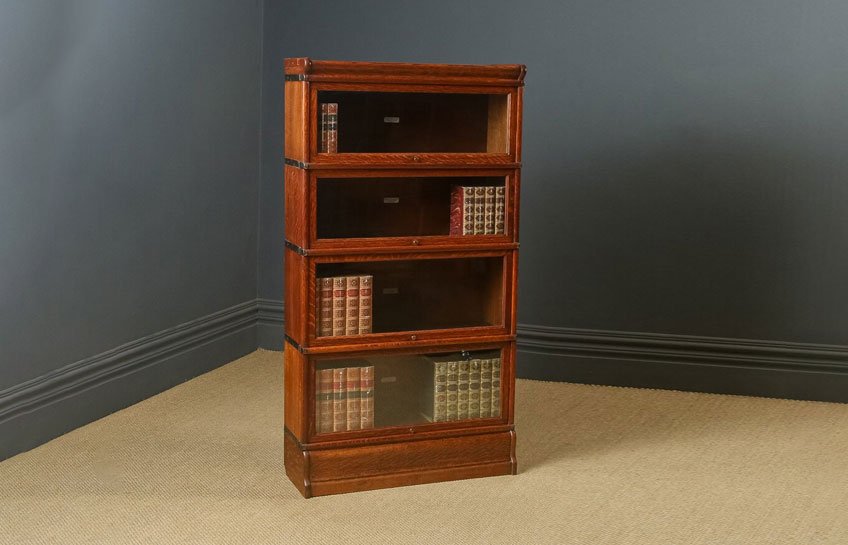If you’re wondering how to date Globe Wernicke bookcases, understanding their age can provide valuable insights into their historical significance and place in American furniture craftsmanship. This detailed guide offers essential techniques to help you pinpoint the manufacturing date of your Globe Wernicke bookcase.
How to Date Globe Wernicke Bookcases
The Globe Wernicke Company stands as one of the most influential American furniture makers from the turn of the 20th century. Founded in Cincinnati, Ohio in 1899, the company pioneered modular bookcases with interchangeable parts that could be configured into countless customized arrangements. Over its nearly 90 years in operation before closing in the late 1980s, Globe Wernicke’s signature bookstacking units and luxurious woods reflected leading furniture trends from Art Nouveau to Art Deco to Midcentury Modern.
For collectors today, identifying the age of a Globe Wernicke bookcase provides insights into the company’s manufacturing techniques and design choices over different periods. It enables a deeper historical understanding of each item as situated within Globe Wernicke’s evolution as well as wider furniture trends across the decades. This guide compiles key strategies to accurately date Globe Wernicke bookcases based on examining wood species, hardware, labeling, design motifs, and other distinguishing details.
Combining hands-on furniture investigation with archival research and expert consultation, the following sections walk through steps to effectively determine the age of Globe Wernicke bookcases in your collection. Let’s explore tips for decoding the rich heritage of this signature American brand.
Identifying Key Characteristics
Carefully examining the materials, construction, and design elements of a Globe Wernicke bookcase provides initial clues for when it may have been built. Key traits to look for include:
Wood Species and Finish
The type of wood and quality of finish offer hints about possible manufacturing dates.
- Early Years: As a newly founded company in the late 1800s, Globe Wernicke exclusively used oak in the production of their earliest bookstacking units. Oak woodgrain visible beneath an aging finish suggests the piece may date back to the company’s early history.
- Later Periods: After the 1930s, Globe Wernicke expanded the wood species used for cases, incorporating rosewood, mahogany, walnut, and other woods. Identifying these materials indicates likely fabrication after the first few decades of the 20th century.
- Wear Patterns: The condition of the original finish also provides clues about age. Carefully inspect areas typically exposed to handling such as edges and shelves. Significantly worn sections suggest considerable age while well-preserved finishes imply a more recent manufacturing date.
Glass Display Doors
The use of glass display doors on the bookcase can provide notable hints about the era:
- Pre-WWI Era: Glass doors were a very popular element of Globe Wernicke bookcases produced in the company’s earliest years around the turn of the 20th century. The prominent use of glass suggests the case dates from the late 1800s through the first couple of decades of the 1900s.
- Post-WWI Era: After World War I, the designs shifted as glass doors became less common. Bookcases from the 1920s and beyond tend to lack glass doors or incorporate them only minimally compared to earlier generations.
Design Elements and Stylistic Changes
Globe Wernicke bookcases embraced the leading furniture design trends of their day. Comparing motifs and aesthetics to prominent styles provides context on possible age:
- Art Nouveau Style: Fluid, bio-inspired forms featuring flowers, vines, arches, and nature motifs characterize Globe Wernicke’s earliest bookcases at the turn of the 20th century, reflecting the sinuous Art Nouveau movement.
- Art Deco Style: The 1920s and 30s brought bolder Art Deco geometric patterns, often with exotic veneers, inlaid designs, and customized metal hardware. Angular, streamlined profiles contrasted the curvaceous Art Nouveau years.
- Midcentury Modern: Post-World War II style focused on minimalism and functionality using new materials like molded plastics and lightweight steel tubing. Clean profiles and tiered, modular components embodied contemporary bookcase designs.
Examining Labels and Tags
Inspect any company labels, stamp marks, or paper tags affixed to the bookcase for potential dating clues.
Handwritten Labels vs Printed Logos
Style of labeling offers indications around the manufacturing era:
- Handwritten Labels: In the company’s earliest decades, small metal plates etched with handwritten style lettering listing the model or style number were typically attached to each section. This naming system gradually became more refined and consistent.
- Printed Color Logos: After the 1960s, mass production enabled Globe Wernicke to transition to cheaper, printed paper stickers featuring the company’s red and blue globe logo badge. The colored branding helps date pieces from this mid-20th century onward period.
Serial Numbers and Manufacturing Dates
Closely check any markings for a recognizable serial sequence:
- Locating Information: Serial numbers engraved or handwritten on back panels or interior sides of sections indicate possible fabrication dates, requiring decoding to unlock meaning.
- Limitations: While helpful, be aware serial numbers only reflect when a certain configuration was assembled from parts, not necessarily original production runs for each component. Dates should be considered in combination with other evidence.
Researching Historical Records
Expanding research beyond the physical item offers supplemental support to confirm possible manufacturing eras suggested by examining wood, hardware, labels, and design motifs.
Archival Resources
Various historical records provide rich context about the company’s history and the evolution of specific models:
- Library Databases: Search trade publications through library systems like Google Books and the HathiTrust Digital Library referencing Globe Wernicke articles and advertisement imagery over different decades.
- Online Archives: Manufacturers and collectors have scanned and uploaded myriad Globe Wernicke catalogs for reference. Review archived imagery of bookcases alongside their listed debut years.
- Company Records: Globe Wernicke historians and enthusiast groups have compiled interactive company histories featuring internal records like patents, catalogs, and ledgers helpful for narrowing dates.
Historical Catalogs and Advertisements
Advertising materials published throughout Globe Wernicke’s operation often included detailed product specifications:
- Compare Details: Matching the materials, hardware, dimensions, and style elements noted in historical product listings against the actual item provides another dating method.
- Align Production Timelines: Globe Wernicke frequently ran updated catalogs multiple times per year as new models debuted. Identifying when a specific bookcase first appeared catalogs brackets potential manufacturing dates.
Consulting Experts
Connecting with specialists familiar with Globe Wernicke’s long production history offers another avenue to validate any preliminary age determinations.
Antique Dealers and Appraisal Services
Those regularly handling Globe Wernicke inventory through buying, selling, and appraising vintage furniture have cultivated specialized knowledge around dating different models:
- Professional Expertise: Longtime dealers specializing in American furniture likely possess extensive familiarity with subtle clues for placing Globe Wernicke models within the company evolution and wider design movements.
- Access to Specialized Knowledge: Auction houses, consigners, and estate appraisers also leverage comprehensive price guides documenting details and chronology of models for accurate valuations.
Online Communities and Discussion Boards
Fellow vintage furniture enthusiasts share insights and research:
- Firsthand Experiences: Active collector forums feature members eager to trace histories of newly acquired bookcases, reporting back discoveries of tagged dates, corroborated comparisons, identified models, and other confirmation details.
- Connecting Around Shared Interests: The niche concentration of collectors focused on a specific manufacturer like Globe Wernicke aggregates valuable specialized knowledge for mutual benefit.
Documentation and Photography
Compiling extensive documentation about your Globe-Wernicke bookcase assembles key information for current understanding and future research.
High Quality Images
- Close-ups of Distinguishing Features: Photograph any labels, engraving, hardware elements, joinery, and other stylistic details that could aid in identification from additional sources.
- Full Views From All Angles: Complete image sets allow comparison of overall sizes, proportions, and design styles with historical bookcase imagery to support dating claims.
Measurements and Dimensions
- Accuracy in Recording Data: Note interior capacity, heights, widths, depths of each unit, and shelf spacing. Matching physical dimensions against product listings helps confirm specific models.
- Useful for Comparison: Even roughly aligned lengths, depths, and heights can assist in era identification when cross-checked with imagery archives of common models across decades.
Condition Assessment
- Damage and Imperfections: Carefully log any cracks, scratches, watermarks, repaired areas, or anomalies like hardware replacements. Documentation assists in authenticating age while tracking any needed restoration.
- Evaluate Relative Wear: Does visible wear appear appropriately aligned with the suspected date range? Light wear on an otherwise pristinely preserved piece causes greater scrutiny. A significant patina that seems plausible for 100-year-old wood lends more credibility.
Cross-referencing Information
Piecing together findings derived from examining physical construction, historical documentation, and expert perspectives provides the strongest grounds for accurately dating Globe Wernicke bookcases.
Combining Multiple Factors holistically
- Seeking Confirmation: Layering evidence from material analysis, archived specification sheets, dealer commentary, and collector forums enables confirmation when multiple sources align on probable eras.
- Assembling a Puzzle: Each small clue around wood type, hardware, labeling, design themes, and dimensions collectively builds the reasoning for pinpointing dates. Overlay findings to identify intersection points.
Addressing Discrepancies
- Resolving Conflicts: If certain factors, like aesthetic styles versus wood species, point toward vastly different eras, carefully reweigh which evidence seems stronger. Seek additional input from experts to settle discrepancies.
- Making Informed Decisions: Given limitations around remake parts or missing data, ultimately use best reasoned judgment in assessing the preponderance of evidence to decide on the most credible manufacturing date range.
Conclusion
This guide presents key strategies to effectively date Globe Wernicke bookcases based on probing signature traits like materials, labeling conventions, evolving design motifs, company history, and documentation methods. Tracing the rich narratives from a family-run 19th century furniture startup to an iconic modern American brand, determining the age of your Globe Wernicke bookcase enables a deeper appreciation for its heritage. Referencing the tips outlined throughout the various sections empowers both novice collectors and longtime enthusiasts to confidently date Globe Wernicke bookcases. Please feel free to contact me with any further questions!




No Comment! Be the first one.